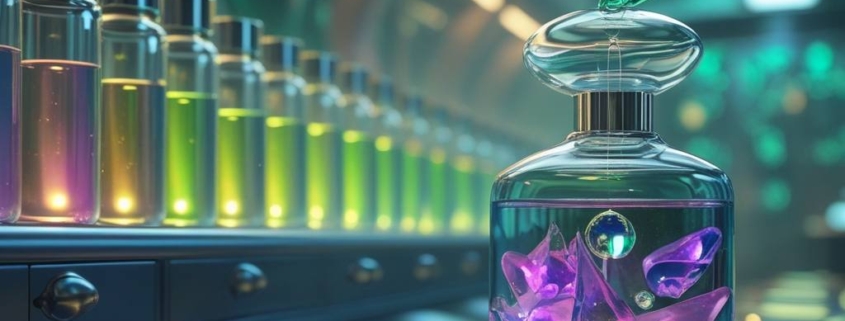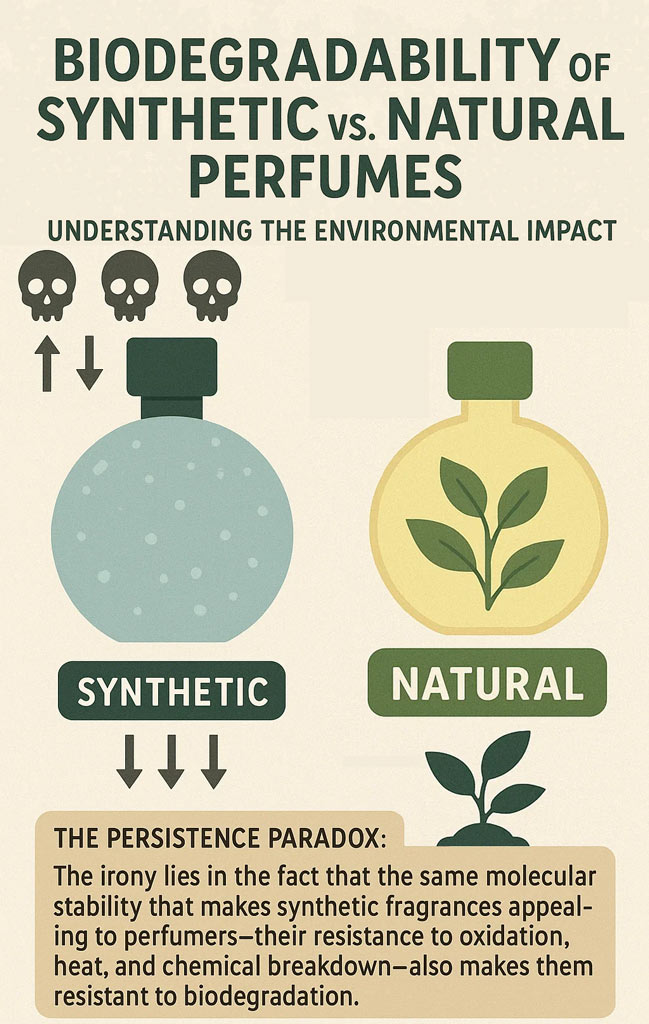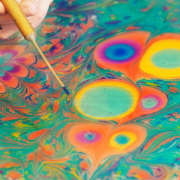Biodegradability of Synthetic vs. Natural Perfumes: Understanding the Environmental Impact

Biodegradability-of-Synthetic-vs.-Natural-Perfumes
The Persistence Paradox: The irony lies in the fact that the same molecular stability that makes synthetic fragrances appealing to perfumers—their resistance to oxidation, heat, and chemical breakdown—also makes them resistant to biodegradation. This creates a fundamental conflict between persistence performance and environmental responsibility.
Table of Contents
-
Understanding Biodegradability in Fragrances
-
Synthetic Perfumes and Environmental Persistence
-
The Persistence Paradox
-
Natural Fragrances and Biodegradation
-
The Role of Molecular Structure in Biodegradability
-
Impact on Aquatic Ecosystems
-
Regulatory Landscape and Testing Standards
-
The Artisanal Advantage: La Via del Profumo’s Approach
-
Making Informed Consumer Choices
In an era where environmental consciousness influences consumer decisions, the fragrance industry is facing increasing scrutiny regarding the ecological impact of its products. The question of biodegradability—how quickly and completely fragrance molecules break down in the environment—has become central to discussions about sustainable perfumery. This comprehensive examination explores the fundamental differences between synthetic and natural perfumes in terms of their environmental fate and impact.
Understanding Biodegradability in Fragrances
Biodegradability refers to the ability of organic substances to be broken down by living organisms, primarily microorganisms, into simpler, harmless compounds such as water, carbon dioxide, and biomass. In the context of fragrances, this process determines how long aromatic molecules persist in the environment after they’re washed down drains or released into the air.
The biodegradation process occurs through various pathways, including aerobic (with oxygen) and anaerobic (without oxygen) decomposition. The rate and completeness of this process depend on several factors, including molecular structure, environmental conditions, the presence of microorganisms, temperature, pH levels, and oxygen availability.
Measuring Biodegradability
Scientists measure biodegradability using standardized tests such as the OECD 301 series, which evaluates how much of a substance breaks down within 28 days under optimal laboratory conditions. Materials achieving 60% degradation are considered “readily biodegradable,” while those falling short may persist in the environment for extended periods.
Synthetic Perfumes and Environmental Persistence
Synthetic fragrance molecules, while revolutionary in their ability to create consistent, long-lasting scents, often present significant challenges in terms of biodegradability. Many synthetic compounds are designed specifically for persistence—the very quality that makes them appealing in perfumery becomes problematic from an environmental perspective.
Common Persistent Synthetic Molecules
Polycyclic musks, such as galaxolide and tonalide, are among the most concerning synthetic fragrance ingredients. These molecules can persist in the environment for months or even years, accumulating in sediments, aquatic organisms, and even human tissue. Their complex ring structures resist breakdown by natural microorganisms.
Nitro musks, though largely phased out, exemplify the persistence problem. These compounds have been found to bioaccumulate in fish and marine mammals, resulting in regulatory restrictions in many countries. Similarly, certain aldehydes and synthetic esters used in modern perfumery show varying degrees of environmental persistence.
The Persistence Paradox
The irony lies in the fact that the same molecular stability that makes synthetic fragrances appealing to perfumers—their resistance to oxidation, heat, and chemical breakdown—also makes them resistant to biodegradation. This creates a fundamental conflict between performance and environmental responsibility.
Natural Fragrances and Biodegradation
Natural fragrance materials, derived from plants, flowers, fruits, and other biological sources, generally demonstrate superior biodegradability compared to their synthetic counterparts. This advantage stems from their evolutionary relationship with the natural world—these molecules exist within ecosystems where organisms have developed mechanisms to process them.
Essential Oils and Biodegradation
Essential oils, the backbone of natural perfumery, consist of complex mixtures of terpenes, esters, aldehydes, and other naturally occurring compounds. Most of these molecules readily biodegrade, often achieving complete breakdown within days to weeks under appropriate environmental conditions.
For example, linalool and limonene, common components in citrus and floral essential oils, typically biodegrade rapidly in both aquatic and terrestrial environments. Similarly, natural esters found in flower absolutes break down efficiently through hydrolysis and subsequent biodegradation of their constituent parts.
Variability in Natural Materials
While natural materials generally biodegrade more readily, there are exceptions. Certain natural compounds, particularly those with complex structures or those that serve protective functions in plants, may show slower biodegradation rates. However, even these typically outperform synthetic alternatives in terms of environmental compatibility.
Examples of Slower-Biodegrading Natural Compounds
Complex Terpenes and Resins:
- Resins like colophony (from pine trees) or benzoin contain highly complex molecules that degrade slowly
- Some diterpenes and triterpenes have such intricate structures that microorganisms struggle to “recognize” and process them
- Ambergris is famous precisely for its persistence – it can last centuries in the ocean
Phenolic Compounds and Lignins:
- Certain natural phenols, like those in sandalwood or oakmoss, have structures that resist biodegradation
- Natural vanillin, paradoxically, degrades more slowly than synthetic vanillin in certain environments
- Tannins found in bark are produced by plants to help resist decomposition, serving as a protective function.
Waxy and Fatty Compounds:
- Natural waxes like carnauba wax or beeswax are specifically designed by nature to be protective barriers
- Some long-chain fatty acids found in certain plant materials can persist longer than expected
- Cutin and suberin (plant protective layers) are naturally resistant to breakdown
The Logic: These compounds have been created specifically to be persistent, because they serve protective functions for plants, defending against insects, fungi, UV radiation, or harsh weather. Their resistance to degradation is actually their “job” in nature.
Important Context: Even these slower-degrading natural compounds typically break down much faster than synthetic musks or other problematic synthetic materials. We’re talking about months versus years or decades. Plus, they don’t bioaccumulate in the same harmful way that synthetic compounds do.
This is why natural perfumery, as practiced at La Via del Profumo, remains a more environmentally responsible choice overall.
The Role of Molecular Structure in Biodegradability
The relationship between molecular structure and biodegradability follows predictable patterns that help explain why natural and synthetic materials behave differently in the environment.
Structural Factors Affecting Biodegradation
Linear molecules generally biodegrade more readily than branched or cyclic structures.1 This principle explains why many natural fatty acid derivatives break down quickly, while synthetic musks with their complex ring systems persist. The presence of functional groups also matters—esters 2 and alcohols typically biodegrade faster than ethers or highly substituted aromatics.
Molecular size also plays a crucial role. Smaller molecules are more readily taken up by microorganisms and processed through metabolic pathways. Many natural fragrance components fall within the optimal size range for biodegradation, while some synthetic polymeric materials exceed the molecular weight threshold for efficient breakdown.
Enzyme Recognition
Natural molecules often contain structural motifs that enzymes readily recognize and process. Microorganisms are equipped with enzyme systems capable of breaking down naturally occurring compounds. Synthetic molecules, particularly those with novel structures not found in nature, may lack suitable enzyme targets for biodegradation.
Impact on Aquatic Ecosystems
The aquatic environment represents the ultimate destination for many fragrance molecules, making the impacts on the water system a critical consideration in biodegradability assessment.
Wastewater Treatment Challenges
Conventional wastewater treatment plants are designed to remove traditional pollutants but often struggle with synthetic fragrance compounds. Many synthetic musks and other persistent fragrance molecules pass through treatment facilities unchanged, entering rivers, lakes, and eventually marine environments.
Natural fragrance materials, conversely, are typically removed more effectively during wastewater treatment. Their biodegradable nature allows them to be processed by the biological treatment systems that form the core of modern sewage treatment facilities.
Bioaccumulation Concerns
Persistent synthetic fragrances can accumulate in aquatic organisms, potentially affecting fish reproduction, immune function, and behavior. Studies have detected synthetic musks in fish tissue worldwide, raising concerns about the impacts on the food chain and long-term ecosystem health.
Research Insight: Studies in European rivers have found that synthetic musk concentrations persist for years in sediments, whereas natural fragrance materials typically exhibit rapid degradation with minimal accumulation.
Testing Requirements
Current regulations typically require biodegradability testing for new chemical substances; however, many legacy synthetic fragrance ingredients were grandfathered in before comprehensive testing requirements were established. This regulatory gap means that some persistent synthetic materials continue to be used despite environmental concerns.
Natural materials generally face fewer regulatory hurdles regarding biodegradability, as their long history of environmental exposure and generally favorable biodegradation profiles make them less concerning from a regulatory perspective.
The Artisanal Advantage: La Via del Profumo’s Approach
As a small, artisanal company dedicated to natural fragrances, La Via del Profumo embodies a sustainable approach to perfumery that inherently addresses concerns about biodegradability. Our commitment to using only natural materials means our fragrances integrate harmoniously with natural cycles.
Sourcing and Sustainability
Our careful selection of natural raw materials ensures not only superior biodegradability but also sustainable sourcing practices. By working with botanical materials that biodegrade readily, we minimize environmental impact while creating fragrances that connect wearers with the natural world.
The artisanal approach allows for careful consideration of each ingredient’s environmental profile. Unlike mass-market manufacturers who may prioritize cost and shelf-stability, we can select materials based on their complete environmental lifecycle, including biodegradability.
Transparency and Traceability
Small-scale natural perfumers like La Via del Profumo can offer complete transparency about ingredients and their environmental impacts. This transparency enables conscious consumers to make informed decisions about the environmental impact of their fragrance purchases.
La Via del Profumo’s Commitment: Every fragrance we compose contains only natural raw materials, hence they readily biodegrade, ensuring that our creations enhance personal beauty without compromising environmental health.
Making Informed Consumer Choices
Understanding biodegradability empowers consumers to make environmentally responsible fragrance choices. The growing awareness of environmental issues has created demand for sustainable options in all consumer categories, including fragrances.
Supporting artisanal natural perfumers represents one of the most direct ways consumers can choose environmentally responsible fragrances. These products typically use ingredients that biodegrade readily and are produced with minimal environmental impact.
The Long-term Perspective
Choosing biodegradable fragrances contributes to long-term environmental health. While individual purchasing decisions may seem small, collectively, they drive market demand for sustainable practices and encourage industry-wide adoption of environmentally responsible approaches.
The fragrance industry stands at a crossroads between traditional synthetic chemistry and emerging sustainable practices. As environmental awareness grows and regulatory pressures increase, the advantages of natural, biodegradable fragrances become increasingly apparent.
For consumers seeking beautiful fragrances that align with environmental values, natural perfumery offers an elegant solution. Companies like La Via del Profumo demonstrate that environmental responsibility and olfactory artistry do coexist, creating fragrances that celebrate both human creativity and natural harmony.
The choice between synthetic and natural fragrances ultimately reflects broader values about our relationship with the environment. By choosing biodegradable natural fragrances, consumers support not only their own well-being but also the health of the ecosystems we all depend upon.
NOTES
-
Why Linear Molecules Break Down Faster: A Simple Explanation.
Think of biodegradation like a key fitting into a lock. Microorganisms have evolved “tools” (enzymes) that function optimally with specific molecular shapes.Linear Molecules = Straight Chain: Imagine a straight chain or a simple necklace. These molecules are like a straight line of atoms connected one after another. Examples:
- Natural fatty acids (like those in coconut oil)
- Simple alcohols
- Many natural esters
Branched Molecules = Tree-like Structure: These have “branches” sticking out from the main chain, like a tree with many limbs. They’re more complex three-dimensional shapes.
Cyclic Molecules = Ring Structures: These atoms form closed rings, like circles or multiple interconnected rings – much more complex geometries.
Why the Difference Matters:
- Linear molecules are like straight roads – microorganisms can “travel” along them easily, breaking them apart step by step
- Branched and cyclic molecules are like complex mazes – much harder for enzymes to navigate and break down
Real-World Example:
- A natural linear molecule like citric acid (from lemons) breaks down in days
- A synthetic cyclic musk might persist for years because its ring structure is too complex for natural enzymes to tackle efficiently
In perfumery, most natural fragrance materials have simpler, more linear structures that nature “knows how to handle,” whereas many synthetic fragrances are deliberately designed with complex, branched, or ring structures to increase their longevity, which also makes them more challenging to biodegrade.
This is one reason why natural perfumes, such as those from La Via del Profumo, are more environmentally friendly.
-
Esters vs Ethers: The Key Difference
Esters:
- Chemical structure: R-COO-R’ (they contain a carbonyl group C=O next to an oxygen)
- Think of them as having a “weak spot” – that C=O bond
- Common in nature: found in fruits, flowers, fats, and oils
- Examples: ethyl acetate (fruity smell), benzyl acetate (jasmine-like)
- Easily broken by esterase enzymes – like having a built-in “cut here” line
Ethers:
- Chemical structure: R-O-R’ (just carbon-oxygen-carbon, no carbonyl)
- Much simpler but actually stronger bonds
- Less common in natural fragrances
- Examples: diethyl ether, some synthetic fragrance materials
- Much harder for enzymes to break – no obvious “attack point”
The Biodegradation Difference: Esters are like packages with easy-tear tape – enzymes can quickly “unzip” them at the ester bond, separating them into smaller, easily digestible pieces (usually an acid and an alcohol). Ethers are like sealed plastic containers – there’s no obvious weak point for enzymes to attack, so they persist much longer in the environment.
In Perfumery: Natural perfumes are full of esters (that’s why flowers and fruits smell so good!), while synthetic perfumes often use ethers for longevity – but this persistence that makes them long-lasting on skin also makes them environmentally problematic.
This is another reason why natural perfumes like ours biodegrade much better!

























Leave a Reply
Want to join the discussion?Feel free to contribute!